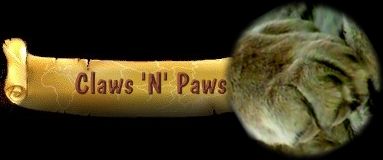
Claws, Paws & Pug Marks - Page 1&2: Claws| 3&4: Pug Marks | 5&6: Declawing

Claws, Paws & Pug Marks -
Page 1&2: Claws|
3&4: Pug Marks
| 5&6: Declawing
Tiger claws:Claws are up to 5 inches in length. Forefeet have five claws, including a dew claw, while hind paws have four claws with the dew claw being absent. Because dew claws are placed high on the limb they do not suffer wear from contact with the ground. This means they become particularly long and sharp, very useful for holding prey. Uses:Claws have a number of uses:
|
|
|
Claws, Paws & Pug Marks - Page 1&2: Claws| 3&4: Pug Marks | 5&6: Declawing Taxonomy
| Whiskers
| Hearing & Ear Spots | Eyesight
| Smell | Teeth
| Communication | Flehman
| Genetics | |
|
Photography
With Thanks To Hasuda Torauma (Photo 1) |